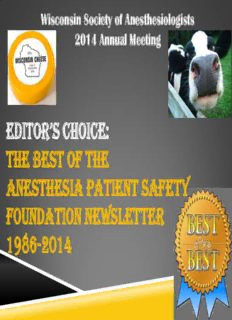
The Best of the Anesthesia Patient Safety Foundation Newsletter 1986-2014 PDF
Preview The Best of the Anesthesia Patient Safety Foundation Newsletter 1986-2014
Wisconsin Society of Anesthesiologists 2014 Annual Meeting Editor’s ChoiCE: The Best of the Anesthesia Patient Safety Foundation Newsletter 1986-2014 Learning Objectives: After this presentation, the participant should be able to: • Discuss the crisis in anesthesia that led to the establishment of the APSF. • Cite three patient safety issues that the APSF Newsletter helped disseminate and how these issues were resolved. • Discuss what features of the APSF make it unique among patient safety organizations. "The Deep Sleep: 6,000 Will Die or Suffer Brain Damage.“ ABC 20/20 April 22, 1982 Crises Create Opportunity Preventable Anesthesia Accidents Poor Patient Outcomes Professional Poor PR Image Liability Crisis Dedicated Individuals in Influential Positions Interested in Patient Safety Ellison C. (“Jeep”) Pierce, Jr, MD • Pierce (1st ASA VP) • 1983 ASA creates Committee on Patient Safety and Risk Management • Jeffrey B Cooper, PhD: Human Errors Research • Critical Incident Analysis • Richard J Kitz, MD: Chair at MGH • Prof. T. Cecil Gray (England) • International Symposium on Preventable Anesthesia Mortality and Morbidity –1984 • Pierce (ASA Immed. Past President) • October 2, 1985 APSF articles of incorporation accepted by ASA Gravenstein Cooper Siker Holzer Pierce Dole Rountree The APSF Executive Committee September 30, 1985 First use of the term “Patient Safety” in a professional organization. “Anesthesia mortality is everybody's problem. Most people will be exposed to the risk several times in their life. When a bad outcome occurs, it affects the” patient family anesthetist anesthetist's colleagues manufacturer & designer of involved equipment hospital administrator professional liability company viability of organization and healthcare system federal government Cooper JB and Pierce EC. For the Executive Committee Vol. 1, No. 1, March 1986 Ellison C. “Jeep” Pierce Robert K. Stoelting 1985-2003 2003-present APSF Presidents
Description: